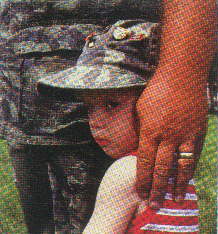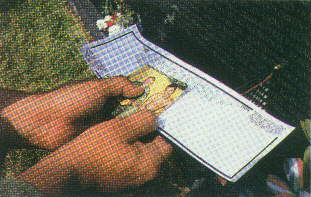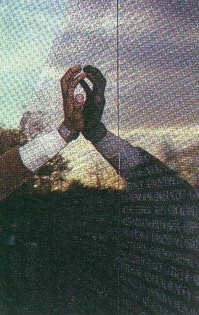-
Copyright © Since 1988
 The American War Library
From Fall 1989
The American War Library
From Fall 1989"COMING TO TERMS WITH NAM"
by Ralph Novak
People Magazine - EXTRA, Fall-1989 The 80's - Starring 20 Who Defined The Decade Photos by People Magazine staff photographers

 The American War Library
From Fall 1989
The American War Library
From Fall 1989
 There are times, though it gets better, when anyone who has been touched by the war can close his eyes, hold out his hands and feel all the lost lives sifting through his fingers-the young Vietnamese and the young Americans, all alike now in this way.
There are times, though it gets better, when anyone who has been touched by the war can close his eyes, hold out his hands and feel all the lost lives sifting through his fingers-the young Vietnamese and the young Americans, all alike now in this way.
The father had been home from the Vietnam War 10 years when his boy was born, on Christmas Day, 1979. The father had been lucky and came home unhurt, untraumatized, unashamed. So it had puzzled him that no one-not even his family and friends-had ever asked about the war. In their silence he had read a judgment: "You must have done terrible things. You must hate to think about it. It's best left alone." At times the father had wanted to grab people by the shoulders and confess: not to misdeeds but to having felt afraid, helpless amid the craziness, at times confused, at times convinced that by serving he had done the honorable thing.
The boy is 9 now, bright, open-minded, gentle.
The great black marble wall on the Washington Mall, dedicated in 1982, is a tragic mirror in which the names of the dead and the faces of the living meet and merge in common humanity.
He could be a fine soccer player, but he doesn't seem to like the hard contact of it. He and his father are playing with toy soldiers. "You take these five," the boy says. "That way you get the one with the machine gun. I know you know how that works." He looks up at his father with what is clearly pride. The father is both touched and troubled, wanting his son to be proud of him, but not for the wrong reasons.
The years when Vietnam veterans were cursed and spat upon, when the Vietnam-vet-gone-berserk was a favorite cop-show premise, were still fresh in the father's mind. Back in 1979, at a Memorial Day gathering in New York to honor Vietnam servicemen, a paraplegic ex-marine named Robert Muller, a spokesman for a group of vets, had angrily confronted the crowd. "You people ran a number on us," he declared. "Your guilt' your hang-ups, your uneasiness, made it socially unacceptable to mention the fact that we were Vietnam veterans. Whenever we brought it up, you walked away from the conversation. "
The veterans' sense of having been grossly mistreated was always exaggerated, the father knew, at least compared with Americans who had fought in other wars. After all, once they had won, veterans of the Revolutionary and Civil wars had been forced to fight long, hard and often unsuccessfully for aid and pensions. Upwards of 25,000 Depression-ravaged World War I veterans descended on Washington, D.C., in 1932's Bonus March and stayed for two months. Korean War returnees were often scorned and, because of a few turncoats, their patriotism was questioned. Hailed and rewarded, the men who fought World War II were the exception, not the rule. But they cast a long shadow, one that fell across the entire Vietnam generation.
Still, in some ways Vietnam soldiers were unique, and not only because they had fought in a losing cause. By the late '70s, reports had begun to surface that veterans who had been exposed in Vietnam to American spraying of defoliants containing dioxin-Agent Orange were suffering unusually high rates of cancer and their children seemed abnormally afflicted with birth defects. Post-Traumatic Stress Disorder was advanced as an explanation for the deranged behavior of some veterans.
Muller's outburst showed the depth of resentment the vets harbored. President Carter seemed to understand the need for a catharsis: the gathering that Muller addressed was part of a national Vietnam Veterans Week, which Congress had endorsed. "The nation," he had declared, "is ready to change its heart, its mind and its attitude about the men who fought in the war." But Carter was too divisive, not a man people could rally around. It remained for Ronald Reagan to catalyze the profound change of heart Carter had foreseen.
As often happened with Reagan, what he said mattered more than what he did. Veterans' organizations frequently castigated him for supporting cuts in federal benefits for ex-GIs, but the specific moral support he wholeheartedly offered helped crystallize a decade of reconciliation. At a Memorial Day ceremony in 1986, for instance, he singled out for praise "the boys of Vietnam, who fought a terrible and vicious war without enough support from home.... They chose to be faithful. They chose to reject the fashionable skepticism of their time; they chose to believe and answer the call of duty."
Rambo's rat-a-tat, provided catharsis on a comic book level. Platoon, below right, presented the trauma of 'friendly fire.' On TV, Tour of Duty brought the war back into the American living room-trivialized, perhaps, but at least acknowledged.
 It seemed to the father that Americans were all too willing to jump on the feel-good bandwagon. In the mid-'80s frequent parades honored Vietnam soldiers. After a New York march in 1985 drew 25,000 participants and a million spectators (at least one of whom held up a sign reading YOU'RE OUR HEROES), one veteran said it was like "a gluttonous feast after years of starvation."
It seemed to the father that Americans were all too willing to jump on the feel-good bandwagon. In the mid-'80s frequent parades honored Vietnam soldiers. After a New York march in 1985 drew 25,000 participants and a million spectators (at least one of whom held up a sign reading YOU'RE OUR HEROES), one veteran said it was like "a gluttonous feast after years of starvation."
The father wondered whether the change in attitude was partially due to Americans' love of being proved right. The continuing exodus of Vietnamese refugees suggested that however misguided we were, our enemies could not have been such wholesome idealists themselves.
And what of the main domestic opponents of the war? Often the father would wonder: How important could the political opinions have been of a woman who would devote much of her time to devising video variations on bouncing and sweating, the better to cultivate her svelte self? Was it, perhaps, some sort of poetic justice delayed that Abbie Hoffman ended up doing bad stand-up comedy, Jerry Rubin hustling as a sorry yuppie pretender, Bobby Seale peddling cookbooks? The quintessential antiwar marriage, between Joan Baez and David Harris, broke up after Harris went to prison for draft evasion. Neither made a big impact on the '80s. George McGovern, who lost the 1972 presidential campaign disastrously, vanished as a moral or political force. By the '80s he seemed just a trivia answer.
But the father had no desire to gloat. Parades did not make it easier for him to play at toy soldiers with his son. Something was missing, unacknowledged. It was not until he visited the dark, downward-sloping Vietnam monument on the mall in Washington, D.C., that he understood what it was. Here, a 480-foot length of black marble became an altar -- a place finally to grieve-and the engraved names of the 58,000 Americans who died became a litany.
The monument had been designed, fittingly, by the daughter of Asian immigrants, Maya Ying Lin, a young Yale architecture student. Between its dedication on Nov. 13, 1982, and mid-1989, 30 million people had come to visit the wall. They ranged from schoolchildren who asked each other, "What was Vietnam?" to veterans who didn't know they had lost a buddy until they saw his name engraved on the marble.
Like other veterans, the father looked for the less familiar but recognizable names-guys he'd met in Oakland or Long Binh or on an R&R bus in Singapore. And, of course, he tried to imagine what his own name would have looked like engraved in the wall, with the marble reflecting someone else's image. When the tears came, there was mourning for the dead; and frustration and bitterness. And there was a deep bewildering swirl of gratitude and doubt. He felt glad to be alive and unsure whether he deserved to be.
The father tried to imagine what his own name would have looked like on the wall.
Standing at the wall, it was hard to identify with a character such as Rambo, so consumed by violence and hatred. The initial Rambo film, First Blood, was released the same year the wall was dedicated. In that film and its blockbuster 1985 sequel, Rambo was a Vietnam vet who had been maligned and mistreated at home. The character was sympathetic on the surface, the father thought, but only in the most dishonest, condescending way. The lampooned combat in the sequel seemed extravagant and ridiculous, demeaning the horror-and the nobility-of the real thing.
The father found Oliver Stone's Platoon (1987) and Stanley Kubrick's Full Metal Jacket (1988) more valid-an education for those who weren't there, a shared nightmare for those who were.
Dan Quayle met the press on the Guard issue.
 In 1983, PBS broadcast Stanley Karnow's 13-part series, Vietnam: A Television History, which the father found insightful. Maybe, he thought, little by little we remember, and everybody learns. Then, beginning with Tour of Duty on CBS in 1987 and China Beach on ABC in 1988, Vietnam came to prime time as entertainment. The father recognized this as a momentous change on some level. Still, the shows made the war seem too routine, too clean. He recalled an evening in 1969, coming back after an all-day patrol to a fire-support base dug in on the Cambodian border.
In 1983, PBS broadcast Stanley Karnow's 13-part series, Vietnam: A Television History, which the father found insightful. Maybe, he thought, little by little we remember, and everybody learns. Then, beginning with Tour of Duty on CBS in 1987 and China Beach on ABC in 1988, Vietnam came to prime time as entertainment. The father recognized this as a momentous change on some level. Still, the shows made the war seem too routine, too clean. He recalled an evening in 1969, coming back after an all-day patrol to a fire-support base dug in on the Cambodian border.
It's not a cartoon where the hero never gets hurt," the father said. "It's a struggle..."
In one bunker the men had tuned in AFVN-TV on battery-powered sets to watch reruns of Combat starring Vic Morrow. How distant, painless and fanciful World War II seemed in those images.
But, he though", 10 years ago a TV series set in Vietnam would have been unthinkable. Maybe the pop-culturization of Vietnam does begin to redress the years when the war and its veterans were damned or ignored. And maybe the veteran's role is to accept that no one who wasn't there can ever fully comprehend the experience, and that the past can not all be made right. As he looked back over the decade, the father could not ignore the breadth of change, could almost hear hardened attitudes yielding, like the crack and groan of lake ice breaking up in the spring:
The government agreed this I year to reconsider Agent Orange's effect on veterans, offering the prospect of federal aid above the $180 million awarded to veterans in 1984 to settle a five-year suit against the companies that produced the defoliants.
Phill Coleman, of Redondo Beach, Calif., started a Vietnam Data Resource and Electronic Library for use by veterans (for such purposes as pursuing benefit claims) as well as by scholars.
The first American tourists landed in Vietnam in 1985. "Vietnam: Reflexes and Reflections," a collection of art created by soldiers while in-country, toured the U.S.
At the wall, visitors confront the irreducible
Congress passed a bill to fund a memorial to women veterans of the war. By one estimate, 393 courses on Vietnam are being taught at U.S. colleges and high schools, compared with 22 in 1980. In 1980 Geoffrey Steiner, a Cushing, Minn., vet, began planting a 100-acre forest that he hopes will eventually include one tree for every American who died in Vietnam. When he seemed about to run out of money, volunteers helped him raise funds to keep going. There are 143 major Vietnam memorials in the country now; there were two in 1980.
Yet it is clear as well that agonizing problems remain. Today 194 counseling centers continue to treat the psychological problems of Vietnam veterans. An Americal Division veteran in Nevada tries, still, to learn to live with the image inside his head of the day he fired a burst into a group of children to save his own life-one of the children was about to throw a grenade at him. The California Supreme Court invalidated the death sentence of a Vietnam veteran who killed two girls, 7 and 10, because his trial had excluded evidence that he had suffered a traumatic flashback. The Vietnam Veterans of America estimates that, of 2.8 million men who served in Vietnam, 55,000 are homeless.
During the 1988 presidential campaign, the controversy over Dan Quayle's military service showed how easily the wounds can be reopened. That Quayle had gone to considerable lengths to get himself into a National Guard unit seemed in the new climate of acceptance a clear offense. The father could understand people being upset, especially in light of Quayle's hawkishness. On the other hand, there were a lot of times when a lot of people would have loved to have access to the kind of deal he worked. Was he smarter than they were? Luckier? Less courageous?
Well, he thought, Quayle didn't make the war last a minute longer. He paid too. Let it go.
These phenomena are all symptoms of tragedies no mere decade can erase. Most Vietnam vets would probably agree that they are better off in 1989 than they were in 1979, to varying degrees. But a war is never over, finally, until every man and woman who fought in it has died.
The boy knows that there are popular movies and TV series about Vietnam and that some of those toy soldiers he plays with are described as veterans of the war. The father, wanting his son to be proud of him, has talked about being a soldier, has used words-ambush, chopper, firefight - that conjure excitement and triumph. And he has talked about the pain and fear that lived in everyone: "You know how you hate to get a shot and how much you think it hurts? Think of days and days of that. It's not a cartoon where the hero never gets hurt. It's a struggle, one where every minute you have to fight to keep from becoming someone you don't want to be.
"No father wants his son to have to go to war. But some day, when you're grown, you may have to go. If you do, I hope you will come back knowing that you didn't let your friends down, that you learned something and that you tried to do what is right.
"But, most of all, I hope you're one of those lucky enough to come back at all."
 For more information about this article, please write to:
For more information about this article, please write to: Return to Phill Coleman's Main Page
Return to Phill Coleman's Main Page